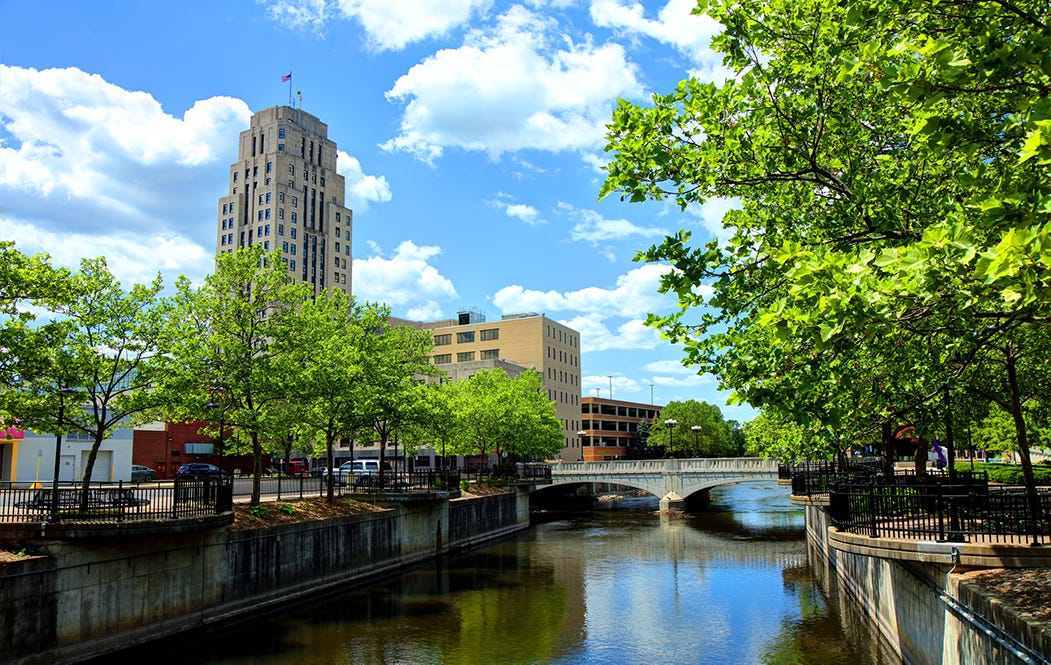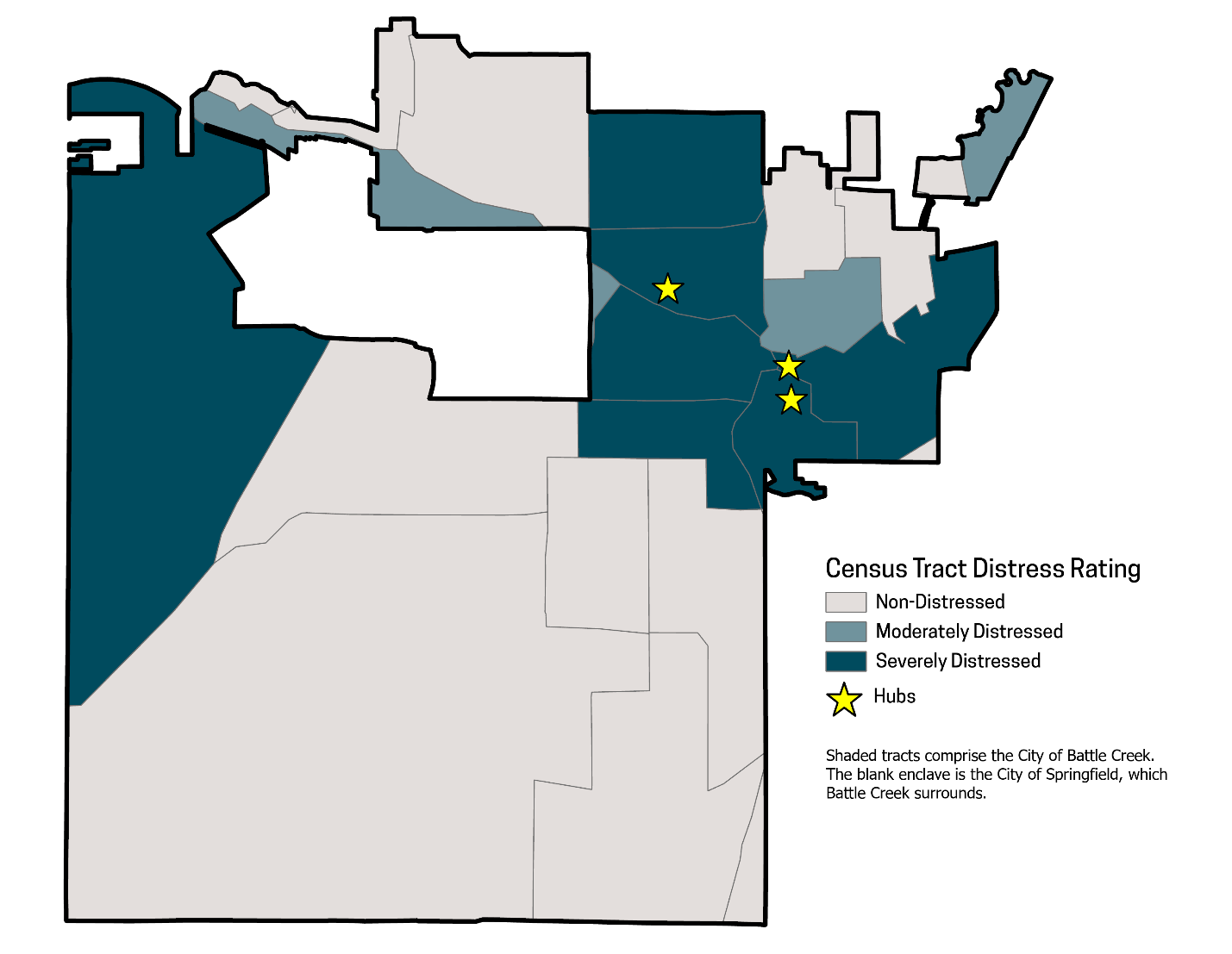Neighborhoods Are Not Local Labor Markets
Different types of distressed places need different solutions.

Bringing jobs to the residents of distressed places across the United States could help both these residents and the nation. These locations have low “employment rates,” or low employment-to-population ratios, and place-based policies could work to improve their residents’ economic conditions.
But distressed places aren’t uniform. It’s crucial to distinguish between neighborhoods and local labor markets, for instance. A “local labor market” is a geographic area of one or more counties that is internally linked by commuting, and examples include metro areas and rural commuting zones. “Neighborhoods,” on the other hand, constitute much smaller geographic areas of one or more similar contiguous Census tracts.
Local labor markets with low employment rates should be helped by policies that include a strong emphasis on job creation, while residents of neighborhoods with low employment rates do not necessarily benefit from policies that simply plop more jobs down in neighborhoods. Policymakers often assume that policies that work for a local labor market will work just as well for a neighborhood, and many neighborhood policies have focused on incentives for neighborhood job creation and investment. But neighborhood residents benefit more from policies that help improve residents’ ability to access jobs throughout the local labor market.
Take “enterprise zones:” a policy popular among politicians that grants tax breaks or regulatory relief for investment or job creation in a designated distressed zone. This idea dates back to the 1970s in the United Kingdom and the United States, and numerous states have enacted some form of help to distressed neighborhoods via designating them as “enterprise zones”. At the federal level, the most recent incarnation of this approach is the Opportunity Zone program, which offers preferential capital gains tax treatment for those reinvesting gains in a designated zone.
Why doesn’t neighborhood job creation do enough to help a neighborhood’s residents? The answer: most benefits spillover outside the neighborhood.
Multipliers are one source of spillovers, and neighborhood job creation causes two types of multipliers. First, suppliers of goods and services to neighborhood firms will create jobs and, second, retailers who sell to workers at the neighborhood firms or their suppliers will create jobs. However, these “multiplier jobs” will mostly be outside the neighborhood.
Moreover, most jobs located in a neighborhood are not held by neighborhood residents—a second source of spillovers beyond the neighborhood. Average one-way commuting time to work in the United States is over 27 minutes, which is almost surely outside any given neighborhood.
Job vacancy chains are a third source of spillovers. Even if a new neighborhood job goes to a neighborhood resident, most hires will already be employed. This hiring leads to a job vacancy at a site inside or outside of the neighborhood. New jobs lead to job vacancy chains that are only terminated when a job goes either to residents of the local labor market who would otherwise not be employed, or to in-migrants to the local labor market. The non-employed residents at the end of these vacancy chains are typically geographically far from the original neighborhood.
Because of these spillovers, “enterprise zone” programs that boost neighborhood jobs will not do enough to help neighborhood residents. Zones may even have net costs for neighborhood residents: if increased investment in a neighborhood increases neighborhood rents and most residents’ earnings are unchanged, for instance, many residents may have reduced real incomes or even be displaced.
In a local labor market, by contrast, new jobs will generally increase employment rates for residents throughout the local labor market even if some of these new jobs increase in-migration. This holds true to a significant extent regardless of where the jobs are located within the local labor market.
Consider a job created in a suburb. This new position may affect job availability for city residents, even if they lack cars. The new suburban job may go to a suburban resident who previously held a job in the city, and the resulting city job vacancy may be accessible to city residents. As a result, improvements in job creation anywhere in a local labor market tend to spread throughout the local labor market via job vacancy chains.
If jobs anywhere in a local labor market can help residents of a distressed neighborhood, why focus on distressed neighborhoods? One reason is that although some share of new jobs in a local labor market will go to the local non-employed, we would like to increase this share. An increased share is facilitated if distressed neighborhoods’ residents can obtain those jobs. A second reason is that improving distressed neighborhoods has sizable effects on helping the neighborhood’s children to increase their adult earnings.
What can boost employment rates in a neighborhood? Improving neighborhood residents’ access to jobs throughout the local labor market. Better job access is provided in part by job training. However, studies of training programs show that the best training programs spend a majority of their funds not on direct training expenses, but on “wraparound services”. Such wraparound services could include helping neighborhood residents get reliable used cars and improving mass transit as well as high-quality nearby childcare.
Job retention services are another wraparound service. Residents’ ability to retain job can be helped via “success coaches” who provide casework services to new hires from low-income backgrounds and help them overcome problems that may lead to job loss. A job coach might help an employee to get quick access to a loan for car repair, for instance.
Neighborhood job access services can be coordinated via Neighborhood Employment Hubs. My employer, the Upjohn Institute, runs workforce programs in the four-county area around Kalamazoo, Michigan. With funding from the Kellogg Foundation, “Michigan Works Southwest” runs Neighborhood Employment Hubs in low-income neighborhoods in Battle Creek. These hubs are located in trusted neighborhood institutions such as churches, subsidized housing projects, and community action agencies.
Neighborhood Hubs in Distressed Neighborhoods in Battle Creek, Michigan
Job access services promote employment at jobs throughout the local labor market, and many of the best job opportunities for a particular resident may be outside the neighborhood.
Based on research, job access services in distressed neighborhoods can increase residents’ employment rates at a cost per extra job opportunity of less than $70,000. Although $70,000 seems a high cost per extra job, the resulting employment persists for many years. The present value of the extra lifetime earnings will vastly exceed this one-time cost. Furthermore, higher employment rates for a neighborhood’s adults will improve the future earnings of the neighborhood’s children.
The dichotomy between policies to help distressed local labor markets versus neighborhoods should not be exaggerated. Local labor markets can be better helped if job creation policies are complemented by job access policies. Neighborhoods can be better helped if job access programs are complemented by other neighborhood investments.
It’s easier to help distressed local labor markets if we complement job creation with job access policies that encourage a greater share of the jobs to go to residents. Consider customized job training programs: these programs use local community colleges to provide training customized to an individual business’s needs. Providing free customized training can encourage a business to expand jobs in a local labor market. But these training programs can also allow the business’s hiring pool to include more unemployed or under-employed residents.
Neighborhood programs should include job training that help residents who want to start their own businesses. This includes entrepreneurial training programs, small business development centers, and small business incubators. Many businesses started by local residents will remain in their own neighborhoods.
As we improve neighborhood residents’ job access, these residents will be able to afford better neighborhood amenities. If we help residents get better jobs as we invest in neighborhood shopping districts and neighborhood housing, we are more likely to improve the neighborhood itself without displacing the original residents.
Overall, the relative emphasis should be clear: if the local labor market is distressed, a solution should include job creation. If the neighborhood is distressed, a solution should include improved resident job access.
These different solutions for different types of distressed places are due to the fundamental nature of the places. A neighborhood plays a labor market role as a place from which to access jobs. A local labor market is where most jobs are accessed. Policies to boost employment rates of residents of distressed places must recognize the realities of the labor market roles played by different types of places.
Timothy J. Bartik is a senior economist at the Upjohn Institute for Employment Research, a non-profit and non-partisan research organization in Kalamazoo, Michigan. His research focuses on state and local economic development policies and local labor markets. At the Upjohn Institute, Dr. Bartik co-directs the Institute’s research initiative on place-based policies.





